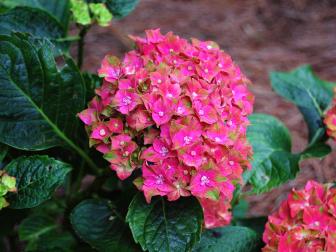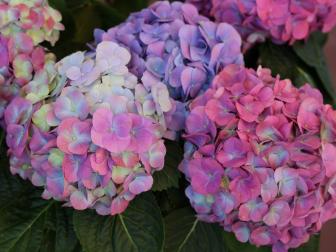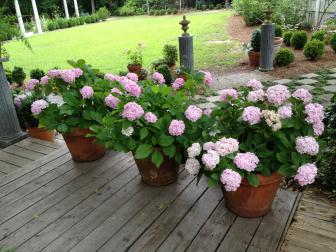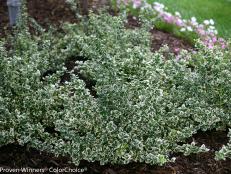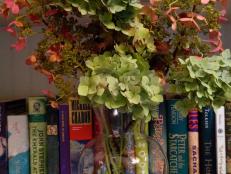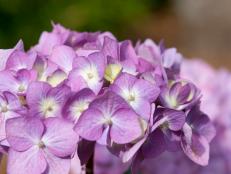Guide to Hydrangea Diseases and Pests
Do your hydrangeas' leaves have brown spots or holes? Stop hydrangea pests and diseases in their ugly little tracks with this easy-to-follow guide.

Photo by Lynn Coulter

One of the nicest things about growing hydrangeas is that they’re relatively trouble-free. But insect pests and diseases can attack, especially in the summer. Use our primer of hydrangea problems — including brown spots on hydreangea eaves — to identify and treat what’s going on in your yard.
Aphids
Primarily a problem on new growth, aphids can be dislodged by spraying your plants with a strong blast of water from the hose. (Be careful not to damage the hydrangea itself.) If they return, try an insecticidal soap or spray. Not sure if your pests are aphids? If you see ants on your hydrangea leaves, small, green aphids are probably around. They like to feed on a sticky substance, honeydew, produced by the ants.
50 Gorgeous Hydrangea Varieties 59 Photos
This beautiful flowering shrub can add color and abundance to your garden.
Powdery mildew
While this disease doesn’t usually kill hydrangeas, it can cause their leaves to drop. It’s characterized by a pale gray, powdery coating on the foliage. Powdery mildew spreads through spores, usually when the days are warm and the nights are cool. Remove and destroy any affected plant parts. For an organic treatment, use a Neem product according to label directions. Avoid watering plants from above, and water early in the day, so leaves have a chance to dry before the temperatures drop at night.
Rust
This fungal disease looks like round, orangish spots on the underside of hydrangea leaves. The tops of leaves turn brown or yellow and eventually fall off. Rust spores are spread in water or on the wind, so avoid splashing your plants when watering. Using soaker hoses rather than sprinklers or spray nozzles can help. If the problem isn’t severe, prune off and destroy the affected leaves. Otherwise, use a fungicide designed to treat and prevent rust.
Japanese beetles
You’ll know Japanese beetles have arrived when you see chewed, holey leaves—and you can’t miss seeing these large insects with metallic green bodies and coppery-brown wings. They seem to prefer oakleaf hydrangeas to other types. The beetles move slowly in the mornings, so that’s a good time to shake them off your plants and into a bucket of soapy water. You can also handpick them. Otherwise, try Neem or pyrethrum before stepping up to more powerful insecticides. Japanese beetle traps use pheromones to catch these pests, but they often attract even more from surrounding areas.
Spider mites
Almost invisible to the naked eye, spider mites cause deformed growth, especially on new stems. While you may not see the mites without a magnifying glass, you’ll recognize their presence by the webs they make between leaves. Since spider mites like hot, dry conditions, you can often control them by keeping your hydrangeas well watered, and by blasting them with water from the hose every couple of days. Many predators eat spider mites, including ladybugs, so use insecticides as a last resort. You don’t want to kill off insects that aren’t doing any harm and that may provide some natural pest control.
Yellow leaves
Most of the time, yellow leaves on hydrangeas are caused by insufficient iron, rather than pests or diseases. To lower your soil’s pH and make more iron available to your plants, add chelated iron to your garden, following the directions on your product. You may need to reapply it yearly, or when the leaves start turning yellow again. For a long-term fix, lower your pH by adding aluminum sulfate to your soil (use a soil test kit to see how much to add), or mulch with pine bark or other acidic, organic matter.
Leaf spots
Small, round, brown or purplish spots on hydrangea leaves are common. Often, affected leaves turn yellowish green and fall off, although the plant usually survives. The problem is caused by a fungus that spreads via spores in wet or humid conditions. To control leaf spot, avoid watering your hydrangeas from overhead, and again, remove and destroy diseased plant parts. If summer rains make the problem worse, try a fungicide such as Immunox (always follow label directions).
Anthracnose
Brown, tan, yellowish or black spots on hydrangea leaves may be anthracnose. You can also identify it by cankers that form on stems and branches. Anthracnose can be fatal to hydrangeas, so prune out dead or diseased plant parts and destroy them. To keep fungal spores from spreading, also remove mulch from the affected area. Use a fungicide designed for anthracnose, and follow label directions carefully.
Flower Colors Fade
If your hydrangea blooms fade fast, they may be getting too much sun, especially if they’re sitting in the hot, afternoon sun. Keep your plants deeply watered in hot weather and layer mulch around the roots to hold moisture in the soil. You may even want to transplant your hydrangeas to a shadier location if they’re not too big, but wait until the weather cools down.
More Advice
How to Plant, Grow and Care for Hydrangeas
No garden’s complete without this old-fashioned favorite, and new varieties make hydrangeas easier than ever to grow.
How to Change Hydrangea Color
Find the secret to changing the hue of these popular blooms.
How to Grow Hydrangeas in Pots
Learn how to grow these ever-popular flowering shrubs in containers for mobile garden color.






